Meet Betsy Smith, newly appointed president of the Central Park Conservancy as she steps into the shoes of Douglas Blonsky
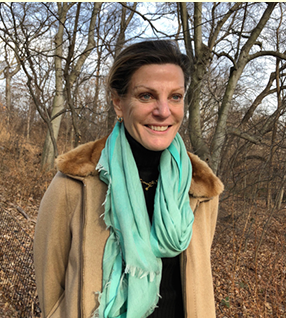 As the Conservancy’s incoming president, Betsy Smith knows that she will not be heading an ordinary, stand-alone, not-for-profit organization. Rather, she will be in charge of one that must, according to its original charter, work in tandem with the city, which has ownership and ultimate policy authority over all municipal parks.
As the Conservancy’s incoming president, Betsy Smith knows that she will not be heading an ordinary, stand-alone, not-for-profit organization. Rather, she will be in charge of one that must, according to its original charter, work in tandem with the city, which has ownership and ultimate policy authority over all municipal parks.
Smith became an assistant commissioner of the New York City Department of Parks and Recreation during Michael R. Bloomberg’s tenure as mayor. Beginning with Park Commissioner Adrian Benepe’s appointment of her as a member of the team the department assigned to interface with Blonsky and the Conservancy’s staff on the management of The Gates project by Christo, she oversaw numerous subsequent events as well as the food concessions and vending operations in Central Park.
The new commissioner makes clear that her focus will be on the ongoing management and restoration plan that has brought about the renaissance of the park during the past thirty-five years. “Parks are at the core of my interest as a citizen,” she says. “The sheer beauty of the landscape design of Central Park by Frederick Law Olmsted and Calvert Vaux was what got me going down this path. Now, with this opportunity in front of me, I am interested in first finding out the real details of the park’s day-to-day operations and implementation of its restoration projects. I ask myself, “Who are these dedicated people doing the work in the park itself? What are their responsibilities and what are their ideas? How does each member of the Conservancy’s team connect with the park? It is all about a passion for the place, and I would like to understand how that passion emerges in each employee.”
Looking forward, she says, “Management change in any institution is an opportunity to look at things afresh, and that is what I hope to encourage. The Conservancy needs to anticipate new directions in philanthropy, in public-profile building, in technology, and even in the best practices that the Conservancy itself has defined. Doug has always had his eye to the future, and it will be great to continue to have his advice, counsel and involvement, especially with regard to the CPC Institute for Urban Parks, which has a tremendous opportunity to share with other parks what we have learned over the years. Almost everyone would agree that great cities need great parks, and great parks need great management. We can and should help other parks, and we will.”
As retiring president and CEO of the Central Park Conservancy, Douglas Blonsky leaves behind an extraordinary legacy
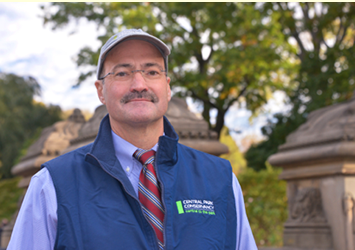 With a career spanning thirty-three years, Douglas Blonsky has helped bring this world-famous landscape from the brink of destruction to its current glory as New York City’s chief oasis of nature and recreation. Hired by the Conservancy’s founding president Elizabeth Barlow Rogers in 1985, Blonsky served as manager of the public-private partnership’s first carpentry and masonry restoration crew and subsequently as head of its office of landscape design and construction. In 1998 he became the Central Park administrator, a Parks Department position, and in 2004 he was selected to occupy the dual role of park administrator and Conservancy president / CEO. Upon his retirement announcement last June 6, his record of accomplishment was recounted in the New York Times in terms of highest praise.
With a career spanning thirty-three years, Douglas Blonsky has helped bring this world-famous landscape from the brink of destruction to its current glory as New York City’s chief oasis of nature and recreation. Hired by the Conservancy’s founding president Elizabeth Barlow Rogers in 1985, Blonsky served as manager of the public-private partnership’s first carpentry and masonry restoration crew and subsequently as head of its office of landscape design and construction. In 1998 he became the Central Park administrator, a Parks Department position, and in 2004 he was selected to occupy the dual role of park administrator and Conservancy president / CEO. Upon his retirement announcement last June 6, his record of accomplishment was recounted in the New York Times in terms of highest praise.
According to Rogers, “Trained as a landscape architect, Doug has a superb grasp the art of historic park restoration. The park speaks for itself. Because each restoration project has added to its overall beauty, he has been able to interest an ever-increasing body of donors to support the Conservancy. But restoration alone is not enough. Without good day-to-day management, it would soon deteriorate again. When I asked Doug recently to comment on the ways in which strategic park management works both in Central Park and as a model for parks elsewhere, he said, ‘It is really based on constant oversight of every section of the park as well as the digital technology that facilitates the collection of a multiplicity of park-wide data. Here is an example: the zone gardener will walk his or her site daily and report such things as a broken bench or tree limb to the section supervisor, who in turn will relay this information to our maintenance headquarters at the Seventy-Ninth Street Yard where it will be logged into a database. This provides a way to determine what level of attention is required, prioritize the tasks that need to be done, and develop a schedule for dispatching the appropriate staff or outside contractor.’ As he described this paragon of park management and how the work of the current field personnel is supplemented by three hundred and fifty regular volunteers, I thought to myself, ‘Wow, how far things have come since the early days of the Conservancy when I was organizing school groups, summer interns, and a few green thumbs to pull weeds and perform some other horticultural good deeds in random locations – now the volunteers are a regular army!’ ”
Fortunately, Blonsky will still be on hand as an advisor to the Conservancy-run Institute for Urban Parks. As he transitions seamlessly into this new role, he says, “I am excited about sharing what the Conservancy has developed and learned over the past thirty-eight years with parks locally, nationally, and elsewhere throughout the world.”
Henry David Thoreau: A Life by Laura Dassow Walls
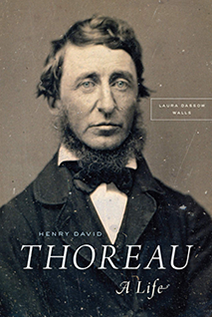 In her excellent biography Henry David Thoreau: A Life published by the University of Chicago Press in 2017, Laura Dassow Walls, professor of English at the University of Notre Dame, tells us that there was much more to Thoreau than his brief experiment living at Walden Pond. A member of the vibrant intellectual circle gathered around his Concord neighbor Ralph Waldo Emerson, he lived as a philosopher, naturalist, manual laborer, surveyor, inventor, and radical political activist. Drawing on his famous book Walden and other copious writings, both published and unpublished, as well as his frequent lyceum speeches and regular journal entries, Walls presents a vigorously alive Thoreau, a man ever observant of nature in all its manifestations, an inveterate long-distance walker, a devoted son, brother, and friend, as well as a trenchant critic of his neighbors’ self-defeating attitudes about material wealth and hidebound social tradition. More than just a chronicle of an individual life lived with passionate curiosity, this book is a sympathetic exploration of the depths and heights of the human soul.
In her excellent biography Henry David Thoreau: A Life published by the University of Chicago Press in 2017, Laura Dassow Walls, professor of English at the University of Notre Dame, tells us that there was much more to Thoreau than his brief experiment living at Walden Pond. A member of the vibrant intellectual circle gathered around his Concord neighbor Ralph Waldo Emerson, he lived as a philosopher, naturalist, manual laborer, surveyor, inventor, and radical political activist. Drawing on his famous book Walden and other copious writings, both published and unpublished, as well as his frequent lyceum speeches and regular journal entries, Walls presents a vigorously alive Thoreau, a man ever observant of nature in all its manifestations, an inveterate long-distance walker, a devoted son, brother, and friend, as well as a trenchant critic of his neighbors’ self-defeating attitudes about material wealth and hidebound social tradition. More than just a chronicle of an individual life lived with passionate curiosity, this book is a sympathetic exploration of the depths and heights of the human soul.
Board Member Robin Karson made honorary member of the American Society of Landscape Architects
The Foundation for Landscape Studies is proud to announce that FLS board member Robin Karson was recently made an honorary member of the American Society of Landscape Architects. Other 2017 awardees include Mitchell Silver, Commissioner of the New York City Department of Parks and Recreation, and Eric Garcetti, Mayor of the City of Los Angeles.
The award cites Karson's service to the profession as author of several influential books and through her work as founder and director of the Library of American Landscape History.
"It's important to acknowledge the reach of the Library of American Landscape History," notes renowned landscape architect Gary Hilderbrand, among five ASLA members who nominated Karson, "with serial books, periodicals, and symposia aimed at a wider shared knowledge of the forces that shaped the designed American landscape.
This is Robin’s legacy. She has built a connective, persuasive coalition that stretches across the U.S., bringing together leaders with diverse backgrounds and a common, driving commitment to knowledge in the field."
In the early 1980s, Karson began researching the life and work of the landscape architect Fletcher Steele – a process that grew into a passion for landscape, history, and preservation. After the publication of her award-winning biography, Fletcher Steele, Landscape Architect, in 1989, she developed the first nonprofit organization in the country dedicated to the publication of books about the American landscape.
LALH is now in its twenty-fifth year and has published books on topics as diverse as environmental history, native plants studies, segregation in state parks, and the work of little-known landscape architects whose designs have shaped America.
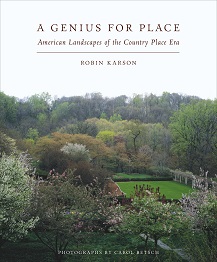 A hallmark of LALH’s anniversary year was the completion of the Warren Manning Research Project, an unprecedented collaborative effort involving hundreds of volunteers throughout the country, all working to document the legacy of this important yet obscure practitioner. The result of this national effort, Warren H. Manning, Landscape Architect and Environmental Planner, is the only source of information on Manning and his over 1,600 projects throughout the nation.
A hallmark of LALH’s anniversary year was the completion of the Warren Manning Research Project, an unprecedented collaborative effort involving hundreds of volunteers throughout the country, all working to document the legacy of this important yet obscure practitioner. The result of this national effort, Warren H. Manning, Landscape Architect and Environmental Planner, is the only source of information on Manning and his over 1,600 projects throughout the nation.
The project’s unique strategy of community outreach galvanized volunteers to identify previously unknown Manning landscapes, from parks and public gardens to entire city plans.
Over the last decade, LALH has become a national voice in debates about the value of cultural landscapes, the importance of environmental design, and the need for landscape preservation. The organization reaches a broad audience through North America by Design, a documentary film series, and its museum exhibits educate visitors throughout the nation. LALH’s annual magazine, VIEW, has expanded to become a nationally significant publication – the only journal of its kind in the field.
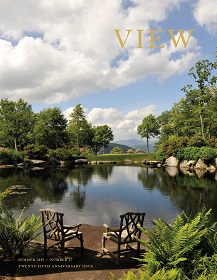 In the pages of VIEW, readers experience the breadth of Karson’s vision of the American landscape. The magazine includes articles on current practitioners as well the pioneers who preceded them, stories about extraordinary efforts to restore landscapes across the country, and interviews with historians, conservationists, and practitioners on topics relevant to the field. Karson has always understood that increasing public awareness of the landscape is about illustrating the cultural value of place and sharing a sense of wonder for the natural world.
In the pages of VIEW, readers experience the breadth of Karson’s vision of the American landscape. The magazine includes articles on current practitioners as well the pioneers who preceded them, stories about extraordinary efforts to restore landscapes across the country, and interviews with historians, conservationists, and practitioners on topics relevant to the field. Karson has always understood that increasing public awareness of the landscape is about illustrating the cultural value of place and sharing a sense of wonder for the natural world.
It is fitting then that the ASLA has awarded Robin Karson an honorary membership in its organization, and that this acknowledgement of her profound contribution to the field of landscape architecture should come as LALH celebrates twenty-five years of scholarship and landscape stewardship.
Board Member Laurie Olin is honored by the National Building Museum
With the receipt of the Vincent Scully Prize, Laurie Olin joins Jane Jacobs, His Royal Highness Prince Charles, Phyllis Lambert, and Andres Duany in the museum's pantheon of those deemed most influential in shaping our built environment.
In a brief tour of some of his greatest work – including the landscapes of the National Gallery of Art sculpture garden and National Monument, as well as the Getty and Barnes museums – Olin expressed his joy in creating democratic spaces for people. He was interviewed by landscape architect James Corner, ASLA, founder of Field Operations, a former student of his.
Some highlights from the wide-ranging lecture and conversation with Corner:
“I aim for creating a sense of calm resolve, a quiet seamlessness. The heavy lifting is hidden; I want to make it look effortless. This, however, can cause problems for me: people will see my projects and ask: ‘Why did it cost so much? What took so long?'”
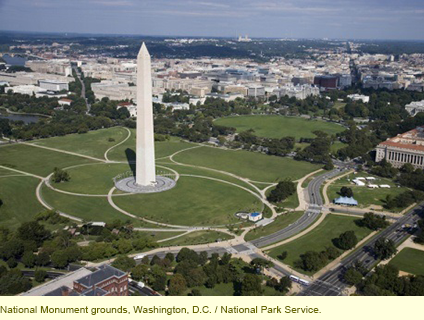 “Landscape architecture is not the sauce you pour over something; it’s part of the structure of an environment. When talking to people who don’t know what landscape architecture is, steer the conversation to another level. Landscape is a device for that.”
“Landscape architecture is not the sauce you pour over something; it’s part of the structure of an environment. When talking to people who don’t know what landscape architecture is, steer the conversation to another level. Landscape is a device for that.”
“Landscape architecture is not the sauce you pour over something; it’s part of the structure of an environment. When talking to people who don’t know what landscape architecture is, steer the conversation to another level. Landscape is a device for that.”
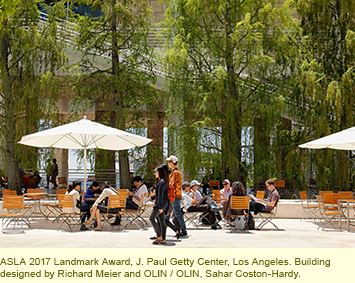 “Many things have changed since I started practicing in the 1970s. Many processes have changed for the better, thanks to new technologies. However, our faster world has caused impatience among clients. They say: ‘Why isn’t this done? We just emailed you yesterday.’ Digital technologies have made it harder to take time to slow down, stop, and think. Projects that take longer, that stall, are better because of the slowness. There is more time to consider. Landscape architecture is the slow food of design.”
“Many things have changed since I started practicing in the 1970s. Many processes have changed for the better, thanks to new technologies. However, our faster world has caused impatience among clients. They say: ‘Why isn’t this done? We just emailed you yesterday.’ Digital technologies have made it harder to take time to slow down, stop, and think. Projects that take longer, that stall, are better because of the slowness. There is more time to consider. Landscape architecture is the slow food of design.”
“In the 1970s, most landscape architects were working in the suburbs; today, they are fully engaged in the city, because that’s where the people are. Then, just getting an urban mini-park built was seen as a major triumph; today, landscape architects are creating larger urban parks and even regional plans.”
On working with “starchitects” like Frank Gehry, Norman Forster, and Richard Meier: “Architects are control freaks. They have to be. It’s hard to get things done, or even done well, and especially hard to get something done brilliantly. So they become maniacs. It’s important to learn their ways of thinking, but then you have to push back.”
“Some people will say they can see a project and know it’s my work. But I don’t have a style. They are looking more at the handwriting than the style."
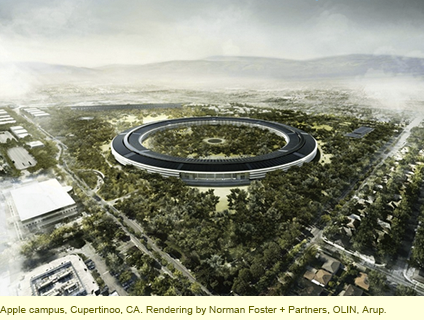 On the controversial new 150-acre Apple campus in Silicon Valley, a collaboration with architect Norman Forster: “Steve Job’s idea was a forest – a big park – for his campus for tens of thousands of employees. He believed in nature and the health benefits of the natural world. His favorite park was Hyde Park in London. He was also a fan of Frederick Law Olmsted and studied his work. His vision was a park that was also an everyday workplace, where employees could go have walks and meetings under a tree. I agreed with this vision.”
On the controversial new 150-acre Apple campus in Silicon Valley, a collaboration with architect Norman Forster: “Steve Job’s idea was a forest – a big park – for his campus for tens of thousands of employees. He believed in nature and the health benefits of the natural world. His favorite park was Hyde Park in London. He was also a fan of Frederick Law Olmsted and studied his work. His vision was a park that was also an everyday workplace, where employees could go have walks and meetings under a tree. I agreed with this vision.”
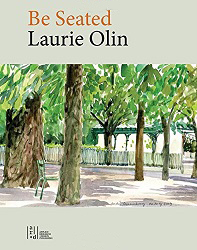 On the role of new parks in gentrification: “We need a green public realm for the health of our populations. We need places where citizens can come together. We need to spend money and build things well.” The way to address gentrification is to “eliminate the inequalities” in access to great parks. “We need to bring great parks to places like North Philadelphia.”
On the role of new parks in gentrification: “We need a green public realm for the health of our populations. We need places where citizens can come together. We need to spend money and build things well.” The way to address gentrification is to “eliminate the inequalities” in access to great parks. “We need to bring great parks to places like North Philadelphia.”
“Fears about community, other people, or terrorism negatively affect our public spaces. I believe in an open society and open environment. We can bring optimism and resistance – we can push back with good design.”
On President Trump’s proposed wall along the southern border with Mexico: “I disapprove of that on ecological, environmental grounds alone. The climate, ecosystems, and geology – and the people – run north south. You can’t divide people. I totally disagree.”
Olin’s new book, “Be Seated,” examines the role of seating in the public realm and includes many of his original drawings and watercolors.
Site/Lines Fall 2017: Transforming the Planet: Landscape as Habitat
Living as we do in the era that many scientists characterize as the Anthropocene, the geological age in which human activity has become the dominant influence on climate and environment, our species, Homo sapiens, is the primary agent in the wanton extinction of countless other inhabitants of the biosphere. The quadrupling of the earth’s population from 2.5 billion in 1950 to 9.8 billion in 2050 will exacerbate to an almost unimaginable degree the losses already sustained in the animal and vegetable kingdoms. The forecast of ongoing harm by reckless emissions of greenhouse gases in the atmosphere, alterations of the oceans’ chemistry, and unbridled exploitation of Earth’s natural resources should be cause for deep concern, not greed and denial.
In his essay “Revive and Restore: Healing the Landscape through De-extinction,” Fred Rich argues that science, with its ability to edit DNA to reintroduce the key traits of an extinct plant or animal, implies a moral duty to use that power, at least in the case of species whose extinctions were caused by man. Dan Flores takes up the theme of re-wilding in his article, “Silence and Emptiness,” in which he discusses a fifteen-year-old, $100 million-plus, privately funded project to create a Great Plains wildlife park. It would feature animals that once roamed the region, which he documented in his acclaimed 2016 book An American Serengeti.
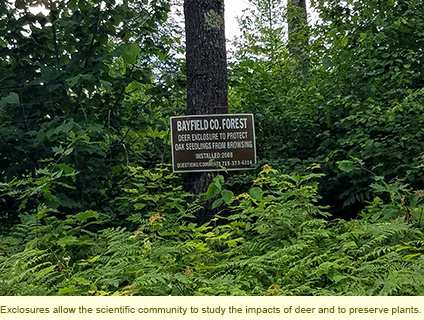 But what about rampant and unwanted growth of animal populations in habitats that have shrunk to fractions of their original extents? Julia Buckles, who takes us on a wilderness trek in “Wisconsin’s Disappearing Forest,” describes white-tailed deer as “plant-eating machines” (they consume seven pounds of vegetation daily). Today these herbivores are multiplying due to milder winters, hunters who have a selfish interest in their unchecked procreation, and land-management officials who ignore their depredations. The environmental scientists the author interviews maintain that what is needed for habitat stabilization in this case are same kind of wire fence exclosures gardeners have begun installing to prevent deer from dining on their horticultural specimens.
But what about rampant and unwanted growth of animal populations in habitats that have shrunk to fractions of their original extents? Julia Buckles, who takes us on a wilderness trek in “Wisconsin’s Disappearing Forest,” describes white-tailed deer as “plant-eating machines” (they consume seven pounds of vegetation daily). Today these herbivores are multiplying due to milder winters, hunters who have a selfish interest in their unchecked procreation, and land-management officials who ignore their depredations. The environmental scientists the author interviews maintain that what is needed for habitat stabilization in this case are same kind of wire fence exclosures gardeners have begun installing to prevent deer from dining on their horticultural specimens.
In “The Many Currents of the Mighty Hudson,” biologist and environmental-research scientist John Waldman provides a case study of the radical transformation of the river’s ecology in direct response to legislation – most notably the Clean Water Act of 1972 and subsequent strictures on dumping toxic industrial waste into waterways. This is a hopeful story that takes us from the mid-twentieth century annihilation of once-abundant species to the present-day, astonishing return of large sturgeon, striped bass, and bluefish; the successful seeding of oyster beds; and the post-pesticide-use presence of once-endangered Bald Eagles and Ospreys.
While this is cause for celebration, Roger Pasquier’s “Interrupted Landscapes: The Future of Bird Migration” explains how, although all seems well on a beautiful spring day in the bird-teeming paradise known as Central Park's Ramble, the avian streams that ply the air currents of the Atlantic Flyway and other migratory corridors throughout the world are being compromised by shrinking forest acreage, sprawling suburbanization, destruction of breeding territories, and climate change
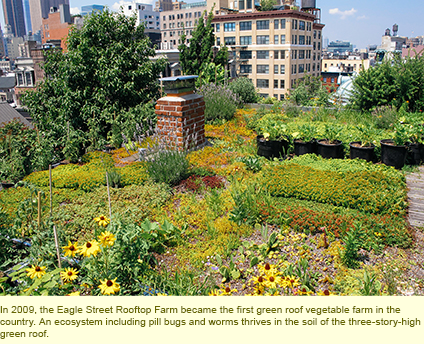 In “Living the High Life: Green Roofs as a Biodiverse Frontier” Annie Novak, herself a rooftop gardener in New York City, adds another dimension to the prescriptions of the writers mentioned above who seek to redress the balance of nature. She maintains that we are living in a world that is undergoing a second agricultural revolution at the same time that it is being transformed by information technology. As she shows, urbanites are finding that the tops of buildings are fertile fields for growing organic produce to feed local populations. But this is not all: There is a large biodiversity benefit as insect pollinators arrive, migratory birds refuel, and wildflower rarities without ground-level soil regenerate
In “Living the High Life: Green Roofs as a Biodiverse Frontier” Annie Novak, herself a rooftop gardener in New York City, adds another dimension to the prescriptions of the writers mentioned above who seek to redress the balance of nature. She maintains that we are living in a world that is undergoing a second agricultural revolution at the same time that it is being transformed by information technology. As she shows, urbanites are finding that the tops of buildings are fertile fields for growing organic produce to feed local populations. But this is not all: There is a large biodiversity benefit as insect pollinators arrive, migratory birds refuel, and wildflower rarities without ground-level soil regenerate
These essays can now be read online as well as in paper format if you are a regular supporter to the Foundation for Landscape Studies. To help keep both formats in circulation in the future, please donate today.
Gold Medal Winner
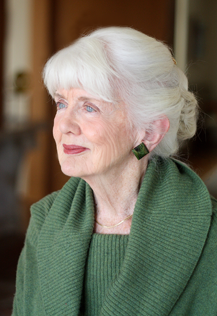 The Foundation for Landscape Studies proudly announces president Elizabeth Barlow Rogers’s receipt of the New York Botanical Garden’s prestigious Gold Medal on November 17, 2016. Previous recipients of this infrequently conferred honor include the sociobiologist, naturalist, and conservationist E. O. Wilson; the neurologist, physician, and author Oliver Sacks; and the British botanist and ecologist Sir Ghillean Prance.
The Foundation for Landscape Studies proudly announces president Elizabeth Barlow Rogers’s receipt of the New York Botanical Garden’s prestigious Gold Medal on November 17, 2016. Previous recipients of this infrequently conferred honor include the sociobiologist, naturalist, and conservationist E. O. Wilson; the neurologist, physician, and author Oliver Sacks; and the British botanist and ecologist Sir Ghillean Prance.
According to Gregory Long, president and CEO of the New York Botanical Garden, the award is “a fitting way to commemorate Rogers’s dedication to New York City in the fields of urban park development and landscape history.” In reply, Rogers said, “I am thrilled to receive such an accolade, but any praise of me must also go to the men and women who stood by my side during the first fifteen years of the life of the Central Park Conservancy and those who continue to make this public-private park partnership a shining example for others throughout the world. I am further grateful for the recognition of the role the Foundation for Landscape plays in nurturing the related fields of landscape history and landscape preservation.
A Political Imperative
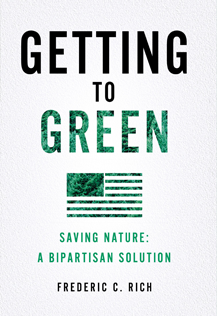 In Getting to Green, Rich argues that the Green movement in America has lost its way. Congress has not passed a major piece of environmental legislation for a quarter century. Environmentalists declared climate to be their top priority, but could not bring a carbon-cap-and-trade bill to a vote, even with Democrats in control of Congress. For conservative Republicans, anti-environmentalism has become an article of faith. Pew polling reveals that the environment is one of two things about which Republicans and Democrats disagree most. How did this happen, and what can be done?
In Getting to Green, Rich argues that the Green movement in America has lost its way. Congress has not passed a major piece of environmental legislation for a quarter century. Environmentalists declared climate to be their top priority, but could not bring a carbon-cap-and-trade bill to a vote, even with Democrats in control of Congress. For conservative Republicans, anti-environmentalism has become an article of faith. Pew polling reveals that the environment is one of two things about which Republicans and Democrats disagree most. How did this happen, and what can be done?
The author starts by telling the story of American conservation’s conservative roots and the bipartisan political consensus that had Republican congressmen voting for, and Richard Nixon signing, the most important environmental legislation of the 1970s. He then narrates the gradual loss of that consensus and its replacement with the “Great Estrangement”: a conservative movement dominated by those deeply suspicious of Green goals and hostile to virtually all policies advocated by environmentalists, and a Green movement that all too often appears antagonistic to business and economic growth.
Rich argues that getting the Green movement back on track requires change in three main areas. First, instead of giving up on conservatives, we must seek to reconnect a critical mass of moderates and conservatives with their long tradition of support for conservation. Second, to succeed in the next fifty years, environmentalism needs a coherent, strong, and sustainable rationale, and one that answers the charge that Greens care more about nature than people. And finally, the modern Green movement, which is now a half century old, must look honestly at its own failings and limitations, and get its house in order for the challenges ahead. This includes putting to rest the old Green refrain that economic growth and big corporations are the enemy.
To order a copy, click here.
Green Metropolis
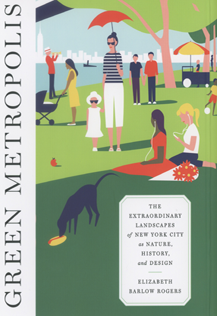 According to Betsy Rogers, coupling the words “nature” and “New York City” is not, as most people think, a dichotomy. Her latest book, Green Metropolis: The Extraordinary Landscapes of New York City, is an exploration of seven New York City landscapes – some fortuitous and others designed. The seven pieces of New York's green fabric she has chosen to describe are the Staten Island Greenbelt, Jamaica Bay, Inwood Hill Park, the Ramble in Central Park, Roosevelt Island, Fresh Kills Park, and the High Line. Chosen for the stories they tell about urban nature, history, and landscape design, they illuminate the physical, social, and cultural factors that have governed the city’s growth and the building of its park system.
According to Betsy Rogers, coupling the words “nature” and “New York City” is not, as most people think, a dichotomy. Her latest book, Green Metropolis: The Extraordinary Landscapes of New York City, is an exploration of seven New York City landscapes – some fortuitous and others designed. The seven pieces of New York's green fabric she has chosen to describe are the Staten Island Greenbelt, Jamaica Bay, Inwood Hill Park, the Ramble in Central Park, Roosevelt Island, Fresh Kills Park, and the High Line. Chosen for the stories they tell about urban nature, history, and landscape design, they illuminate the physical, social, and cultural factors that have governed the city’s growth and the building of its park system.
In addition to describing the original appearance of, and subsequent alterations to, the parks she has chosen to write about, Rogers brings them alive through contemporary voices, including those of their caretakers, regular users, and fierce protectors. More than a guidebook, Green Metropolis gives clear directions on how to get to each of the landscapes discussed via car or public transportation. Now you can discover for yourself some special places within New York City’s five boroughs that you may have never known were there!
To order your copy, click here.
Germany's Green Prince
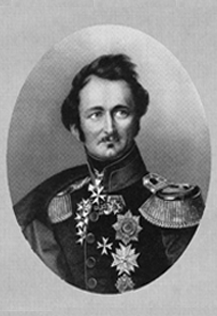 In addition to publishing Hints on Landscape Gardening by Prince Hermann von Pückler-Muskau in association with Birkhaüser in 2014, the Foundation for Landscape Studies has sponsored an English translation of Briefe eines Verstorbenen (Letters From a Dead Man), also the work of the great landowner and garden maker who is sometimes called “Germany’s Green Prince.” Pückler’s letters, which have been translated with fidelity and verve by landscape historian Linda Parshall, were written to his wife Lucie von Hardenberg during his extended journey for the purpose of – yes – marrying a British heiress. Why, you may ask. Reading the letters, it becomes apparent that Pücker was deeply devoted to Lucie. Without severing the bonds of affection and mutual support that united them, they agreed to get what might be termed a divorce of convenience in order to continue their great enterprise, the conversion of his inherited Silesian principality into one vast Romantic landscape, Park Muskau.
In addition to publishing Hints on Landscape Gardening by Prince Hermann von Pückler-Muskau in association with Birkhaüser in 2014, the Foundation for Landscape Studies has sponsored an English translation of Briefe eines Verstorbenen (Letters From a Dead Man), also the work of the great landowner and garden maker who is sometimes called “Germany’s Green Prince.” Pückler’s letters, which have been translated with fidelity and verve by landscape historian Linda Parshall, were written to his wife Lucie von Hardenberg during his extended journey for the purpose of – yes – marrying a British heiress. Why, you may ask. Reading the letters, it becomes apparent that Pücker was deeply devoted to Lucie. Without severing the bonds of affection and mutual support that united them, they agreed to get what might be termed a divorce of convenience in order to continue their great enterprise, the conversion of his inherited Silesian principality into one vast Romantic landscape, Park Muskau.
It is hard to imagine an English bride whose parents have traded a dowry for a title as a happy member of a ménage à trois. But this was an age when many impecunious Continental aristocrats went wife hunting in the world’s most prosperous nation, and no one was deceived as to the respective motives of fortune hunter and social climber. Subterfuge aside, there was nothing particularly reprehensible in Pückler and Lucie’s going to such lengths to obtain the necessary funds to indulge what he called “parkomania”: an insatiable desire to plant and prune trees to frame broad vistas; build carriage drives and pathways to peregrinate through extensive woods and meadows; partially dam streams with boulders to create waterfalls; and employ several gardeners to maintain the most picturesquely naturalistic—yet carefully contrived—panoramic stretch of scenery imaginable.
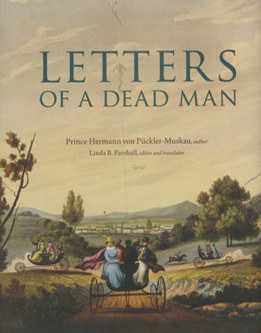 Written in a diaristic mode, the letters are filled with keen observations and delightful descriptions of Regency England in its age of growing prosperity. Since Pückler was a frequent guest in Brighton and London ballrooms, we are treated to numerous charming descriptions of the guests and lavish hospitality he received, which he penned after returning in the dawn hours. In addition, it seems that he traveled everywhere throughout the countryside in his well-appointed carriage, for the letters contain keen observations of scenery and the landscape design of many of the great country estates he visited – again, think Downton Abbey – and where he was frequently a welcome guest. He invariably used such opportunities to walk through the art galleries of his hosts, viewing and commenting on masterpieces by the likes of Titian, Raphael, and Holbein, (these fabulous works of art had not at that time been sold to national museums and American Gilded Age magnates). In these places we follow him outdoors as he gives perceptive critiques from the perspective of an experienced designer.
Written in a diaristic mode, the letters are filled with keen observations and delightful descriptions of Regency England in its age of growing prosperity. Since Pückler was a frequent guest in Brighton and London ballrooms, we are treated to numerous charming descriptions of the guests and lavish hospitality he received, which he penned after returning in the dawn hours. In addition, it seems that he traveled everywhere throughout the countryside in his well-appointed carriage, for the letters contain keen observations of scenery and the landscape design of many of the great country estates he visited – again, think Downton Abbey – and where he was frequently a welcome guest. He invariably used such opportunities to walk through the art galleries of his hosts, viewing and commenting on masterpieces by the likes of Titian, Raphael, and Holbein, (these fabulous works of art had not at that time been sold to national museums and American Gilded Age magnates). In these places we follow him outdoors as he gives perceptive critiques from the perspective of an experienced designer.
Pückler has more to recount than simply the people and places he visited on his pleasure-packed itinerary. In one letter we accompany him as he goes down in a diving bell in order to see a tunnel that is being built beneath the Thames. In another we observe him engaging in friendly conversations with the inmates of Newgate Prison.
Letters of a Dead Man was from the beginning intended for publication once the contents of the packets dispatched to Lucie were collated and edited. The book, which was endorsed by none other than Goethe, enjoyed an instant success and was as popular in England as in Germany. This was fortunate since the bride hunt had not been a success, and the revenues from this runaway best seller subsidized, at least for a few more years, the ongoing improvements to Park Muskau.
The Foundation for Landscape Studies’ new translation, produced in association with Dumbarton Oaks Research Library and Collection and Stiftung Fürst-Puckler-Park Bad Muskau, is a massive, unabridged tome (the original German edition was published in four separate volumes) seven hundred pages in length and weighing eight pounds. At first you will think it too heavy to pick up and much too long to read. Do not be deterred. Once you have started on your travels with Prince Pückler, you won’t be able to put it down.
To read more about this extraordinary book, visit our blog page. To purchase your copy, please click here.
Afton Villa Book
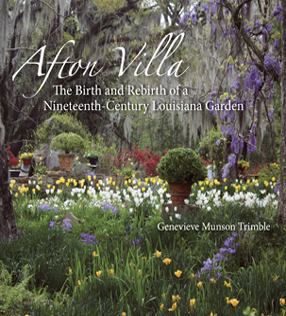 This handsomely illustrated book is a history and memoir by Afton Villa’s owner, Genevieve Munson Trimble, a former Foundation for Landscape Studies Place Maker honoree.
This handsomely illustrated book is a history and memoir by Afton Villa’s owner, Genevieve Munson Trimble, a former Foundation for Landscape Studies Place Maker honoree.
Trimble’s remarkable story begins with a tragedy. In 1963, fire ravaged the forty-room Victorian Gothic plantation home known as Afton Villa, reducing to ashes more than 170 years of history. Soon after it was abandoned, the villa’s carefully laid out garden beds became overgrown with weeds, while rampant vines smothered the twin rows of azaleas lining its serpentine entrance drive.
Limning a portrait of the past as well as a picture of the present, Trimble provides a history of the original owners before recounting the bold decision she and her husband, Bud, made to purchase and resurrect the ruined mansion and its surrounding gardens. In her intimate and loving account of this decades-long restoration project, she demonstrates the way in which creative conservation of the spirit of a place surpasses mere historic preservation of a period artifact.
To order your copy, click here.
2016 Place Maker / Place Keeper Honorees
The Foundation for Landscape Studies is proud to honor John Fairey and Richard Moylan on May 11, 2016, at its annual Place Maker / Place Keeper Awards Luncheon. Please join us in Central Park at the Boathouse! Tickets available here.
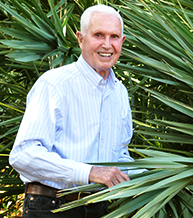 Place Maker
Place Maker
John Fairey’s contributions to the science and art of horticulture are everywhere evident at Peckerwood, the garden he has been continually creating since the early 1970s in Hempstead, Texas, on the outskirts of Houston. A plant explorer, botanical researcher, teacher, and distributer of rare specimens though Yucca Do Nursery, he is also an artist whose landscape design skills take gardening beyond the realm of simple plant display. In addition, Fairey directs Peckerwood’s collaboration with several research institutions on plant conservation and the effects of climate change on gardens in Texas and elsewhere.
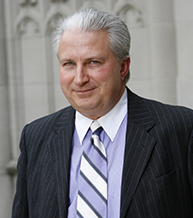 Place Keeper
Place Keeper
Richard J. Moylan has served Brooklyn’s Green-Wood Cemetery with dedication and distinction for more than forty years. Hired as a teenager, he rose through the ranks from groundskeeper to assistant surveyor to landscape supervisor to assistant corporate secretary to Cemetery president, the position he has held since 1986. Famed since its origin in 1838 for its wealth of handsome sepulchral monuments and sculptures, Green-Wood’s collection of mature specimen trees has earned accreditation as an arboretum. Through educational and tour programs that allow the public to enjoy this artistic and botanical heritage, Moylan has opened the gates of this National Historic Landmark to more than 250,000 visitors annually.
Celebration of the publication of A Natural History of English Gardening 1650-1800 by Mark Laird
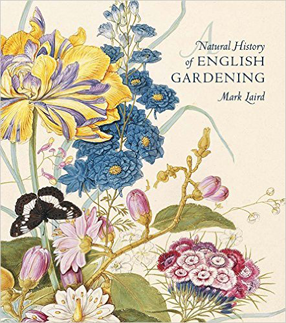 On September 21, 2015, from 4:00 until 6:00, the recently inaugurated the Humanities Institute / LuEsther T. Mertz Library at the New York Botanical Garden will host a celebration in the Mertz Library of this important recent publication. The author will give a short talk about the book, which was published by the New York Botanical Garden in association with the Yale Center for British Art. Following a public discussion, there will be a reception and book signing during which guests are invited to a viewing of the Library’s collection of rare books accompanied by an explanation of their engravings by Vanessa Sellers, director of the Humanities Institute.
On September 21, 2015, from 4:00 until 6:00, the recently inaugurated the Humanities Institute / LuEsther T. Mertz Library at the New York Botanical Garden will host a celebration in the Mertz Library of this important recent publication. The author will give a short talk about the book, which was published by the New York Botanical Garden in association with the Yale Center for British Art. Following a public discussion, there will be a reception and book signing during which guests are invited to a viewing of the Library’s collection of rare books accompanied by an explanation of their engravings by Vanessa Sellers, director of the Humanities Institute.
Mark Laird is a historic landscape consultant and garden conservator and teaches landscape history at the Graduate School of Design, Harvard University. Previous books include The Flowering of the Landscape Garden: English Pleasure Grounds, 1720–1800 and Mrs. Delany and Her Circle (Yale). The Foundation for Landscape Studies is proud that this important contribution to landscape history scholarship was given a 2013 David R. Coffin Publication Grant by its awards committee.
2015 Place Maker / Place Keeper / Lifetime Achievement Honorees
The Foundation for Landscape Studies is proud to honor Stephen Byrns, Tupper Thomas and Charles Eliot Beveridge on May 13, 2015, at its annual Place Maker / Place Keeper Awards Luncheon.
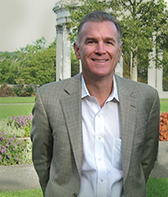 Place Maker
Place Maker
A founding partner of the fifty-person, award-winning architectural firm of BKSK Architects, Stephen Byrns is a graduate of Princeton University and Columbia University School of Architecture. From 2004 to 2010 he served on the New York City Landmarks Preservation Commission and from 2000 to 2010 as a member of the board of directors of Wave Hill.
A Yonkers resident during the 1990s, Byrns was dismayed when he first saw the derelict Untermyer Gardens, once a horticultural showcase but by then a rarely visited, unevenly maintained public park. After founding the Untermyer Gardens Conservancy in 2010, he began working with horticultural advisor Marco Polo Stufano and head gardener Timothy Tilghman to initiate the ongoing restoration of a landscape that was once hailed in the press as “America’s Most Spectacular Garden.”
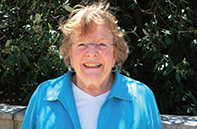 Place Keeper
Place Keeper
The executive director of New Yorkers for Parks since 2014, Tupper Thomas is a graduate of Goucher College. From 1981 to 2011 she served as the administrator of Prospect Park and, beginning in 1987, as founding president of the Prospect Park Alliance, a public-private partnership modeled on the Central Park Conservancy. During her thirty-year tenure, she was responsible for the ongoing operation of Prospect Park, its multimillion-dollar restoration, special events, public information, fundraising, and visitor services.
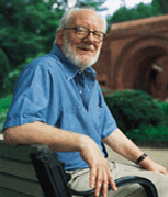 Lifetime Achievement Award
Lifetime Achievement Award
As principal editor of The Papers of Frederick Law Olmsted, Charles Eliot Beveridge, PhD has overseen the publication of eleven volumes of a twelve-volume series of Olmsted’s correspondence, reports, and other writings. In addition, he is the author, in collaboration with the noted photographer Paul Rocheleau, of Frederick Law Olmsted: Designing the American Landscape. As a historical consultant and advisor, he has participated in the preservation of more than forty Olmsted-designed landscapes. He is an honorary member of the American Society of Landscape Architects and a founding member of the National Association for Olmsted Parks. In 2005 the American Society of Landscape Architects awarded him its prestigious Olmsted Medal for environmental stewardship.
Kudos for Board Member Laurie Olin
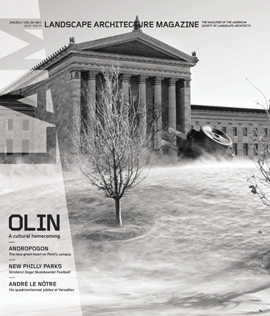 The January 2014 issue of Landscape Architecture Magazine features the OLIN firm’s work in Philadelphia.
The January 2014 issue of Landscape Architecture Magazine features the OLIN firm’s work in Philadelphia.
In the lead article, you can learn about the firm Laurie Olin founded forty years ago and its new generation of partners. Five additional articles highlight recent OLIN projects, including the restoration of the Benjamin Franklin Parkway – Philadelphia’s Champs-Elysées; the design, in collaboration with Todd Williams and Billie Tsien, of the landscape surrounding the relocated Barnes Foundation; the restoration of the grounds of the neoclassical Rodin Museum; the dramatization of the slope adjacent to the Philadelphia Museum of Art as part of a design for a new outdoor sculpture garden; and the reconfiguration of a Philadelphia transit hub into a pedestrian-friendly public space.
While no longer involved with the firm’s day-to-day operations, Olin’s international reputation keeps him in demand both at home and abroad. In the air, he writes; on the ground, he sketches, recording the various landscapes in which he finds himself. The Foundation for Landscape Studies is proud that he is a frequent Site/Lines contributor. To read his meditations on West Coast landscapes, landscapes of stone, and landscapes of institutions, click here.
Celebrate our 2014 Place Maker and Place Keeper Awardees
The Foundation for Landscape Studies is proud to honor William Christie and Adele Chatfield-Taylor on May 1, 2014, at its annual Place Maker / Place Keeper Awards Luncheon. Please join us in Central Park at the Boathouse!
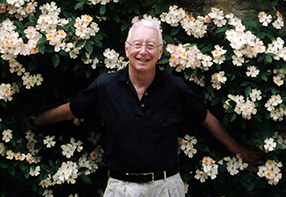 Place Maker
Place Maker
William Christie, musical director, harpsichordist, and founder of the Baroque music ensemble Les Arts Florrisants, has gained renown worldwide for his concert performances. To further training in the seventeenth- and eighteenth-century repertoire, he created an academy for young singers (Le Jardin des Voix) in Caen, France, in 2002. In 2007 he extended his teaching career to include American students, accepting the position of artist-in-residence at the Julliard School in New York City.
A resident of France since 1971, Bill has restored an ancient manor house on his property in the department of the Vendée in the Pays-de-la-Loire region of west-central France. On several acres surrounding the house, he has created a stunning and highly original garden that was designated a monument historique by the French government in 2006. To bring his passion for early music, teaching, and gardening into perfect harmony, in 2012 he launched an annual festival, Dans les Jardins de William Christie. During the festival, laureates of Le Jardin des Voix and Julliard perform throughout the garden.
Bill was named a Chevalier de la Légion d'honneur in 1993 and elected a member of the French Académie des Beaux-Arts in 2008. He is also an officer of the Ordre des Arts et des Lettres.
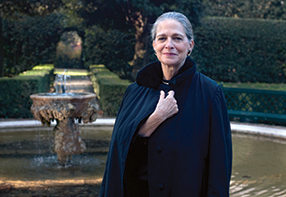 Place Keeper
Place Keeper
Adele Chatfield-Taylor was president and CEO of the American Academy in Rome from 1988 until 2013. During her quarter-century tenure, she led the rebuilding of the institution and its gardens. She oversaw the renovation of the Mercedes and Sid R. Bass Garden, located behind the academy’s McKim, Mead & White headquarters building and the redesign of the Secret Garden of the academy’s Villa Aurelia by Laurie Olin, Millicent Mercer Johnsen, and Alessandra Vinciguerra. She increased the academy’s endowment by nearly ten-fold and restored the number of Rome Prize fellowships to thirty. She supervised the restoration of the Arthur and Janet C. Ross Library and established an endowment for the Drue Heinz Librarian.
For her contributions to the city of Rome, Adele was named a Grande Ufficiale dell’Ordine al Merito by the president of the Republic of Italy in 2002. In 2007 she initiated the Rome Sustainable Food Project under the guidance of Alice Waters. In 2010 the National Building Museum awarded her the twelfth Vincent Scully Prize, which is granted for exemplary practice, scholarship, or criticism in architecture, historic preservation, and urban design.
The Other Las Vegas
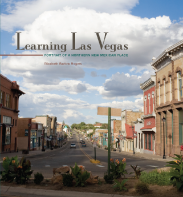 Another Las Vegas? This is the reaction that distinguished author and accomplished photographer Betsy Rogers gets when she explains what her most recent book is about.
Another Las Vegas? This is the reaction that distinguished author and accomplished photographer Betsy Rogers gets when she explains what her most recent book is about.
Unlike its famous Nevada namesake, this Las Vegas is a small town that was once one of the most thriving cities of the American West. Sited on the cusp of the southernmost range of the Rocky Mountains and the Great Plains, it was named by its Hispanic founders after the big meadows – las vegas grandes – that define its unique location at the point where travelers on the Santa Fe trail stopped before continuing on the last leg of their journey through the Glorietta Pass. With the coming of the Atchinson, Topeka, and Santa Fe Railroad in 1879, Las Vegas became a major rail hub for freight as well as passenger transportation. Because of the millions of sheep that grazed on the spacious nearby grasslands, it was for a time the wool capital of the nation. The legacy of this era when Jewish merchants established a vital mercantile economy can be seen in the town’s handsome commercial structures and the mansions and charming Victorian houses that line its tree-shaded streets.
Both its current Hispanic and Anglo residents prefer to consider their town in opposition to Santa Fe, New Mexico’s famous center of international culture. Deep-rooted traditions and home-grown art and entertainment are this community’s cultural mainstays. In the diverse voices of its inhabitants the reader learns about the meaning of place in their lives. An accomplished photographer as well as a distinguished author, Rogers accompanies her narrative with a portfolio of stunning photographs and numerous illustrations.
Here is how one reader summarizes Roger’s achievement:
“Elizabeth Barlow Rogers’s heartfelt and sometimes bittersweet portrait of Las Vegas, New Mexico is an instant classic of Western Americana. Learning Las Vegas reveals the many faces, aspirations, and also tenacity of a Southwestern railroad boomtown that has weathered the storms of history, conquest and injustice, yet boasts rich traditions of culture and picturesque architecture. Masterfully combining the perspectives of a journalist, anthropologist, landscape historian, and photographer, Betsy Rogers’s compelling narratives and conversations with local residents reveal a community at the nexus of the American and Mexican frontiers, sometimes trapped by one or the other and sometimes transcending both.”
– Elmo Baca, author and historic preservationist
To purchase, visit your independent bookstore or click here. To view an online slideshow of photographs from this book, please click here.
Spotlight on Board Members
 Robin Karson, executive director of the Library of American Landscape History, is celebrating the twentieth anniversary of the outstanding publishing organization that she founded. LALH has seen many significant expansions of its program over this period, including the launch in 2012 of two new book series – Designing the American Park and Critical Perspectives in the History of Environmental Design – and a new film series, North America by Design. Visit lalh.org to learn more.
Robin Karson, executive director of the Library of American Landscape History, is celebrating the twentieth anniversary of the outstanding publishing organization that she founded. LALH has seen many significant expansions of its program over this period, including the launch in 2012 of two new book series – Designing the American Park and Critical Perspectives in the History of Environmental Design – and a new film series, North America by Design. Visit lalh.org to learn more.
 Kenneth Helphand, FASLA, Knight Professor of Landscape Architecture, retired from the University of Oregon after forty years of teaching history, theory, and design. On May 25 a symposium, “Landscape Thinking,” was held in his honor in Eugene. The symposium brought together top scholars of landscape architecture to enlighten, delight, and inspire students, professionals, faculty members, practitioners, alumni, and friends. The speakers included Anne Spirn, Walter Hood, Marc Treib, Laurie Olin, Ben Helphand, Cynthia Girling, Alisa Braudo, Tal Alon Mozes and Liska Chan. Helphand’s books include Defiant Gardens: Making Gardens in Wartime (2006), which won several awards, including the Foundation for Landscape Studies 2007 J. B. Jackson Prize; and Dreaming Gardens: Landscape Architecture and the Making of the Israeli Landscape (2002).
Kenneth Helphand, FASLA, Knight Professor of Landscape Architecture, retired from the University of Oregon after forty years of teaching history, theory, and design. On May 25 a symposium, “Landscape Thinking,” was held in his honor in Eugene. The symposium brought together top scholars of landscape architecture to enlighten, delight, and inspire students, professionals, faculty members, practitioners, alumni, and friends. The speakers included Anne Spirn, Walter Hood, Marc Treib, Laurie Olin, Ben Helphand, Cynthia Girling, Alisa Braudo, Tal Alon Mozes and Liska Chan. Helphand’s books include Defiant Gardens: Making Gardens in Wartime (2006), which won several awards, including the Foundation for Landscape Studies 2007 J. B. Jackson Prize; and Dreaming Gardens: Landscape Architecture and the Making of the Israeli Landscape (2002).
Early Central Park Guidebook hot off the electronic press!
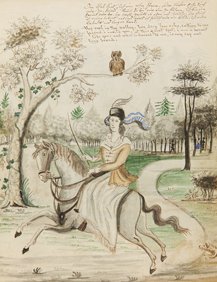 See an annotated digital facsimile of Lewis Miller’s charming drawings of the park when it was first built and read about his remarkable sketches in essays by FLS board member Therese O’Malley and Kathryn R. Barush.
See an annotated digital facsimile of Lewis Miller’s charming drawings of the park when it was first built and read about his remarkable sketches in essays by FLS board member Therese O’Malley and Kathryn R. Barush.
To turn the pages and take a look, click here.
